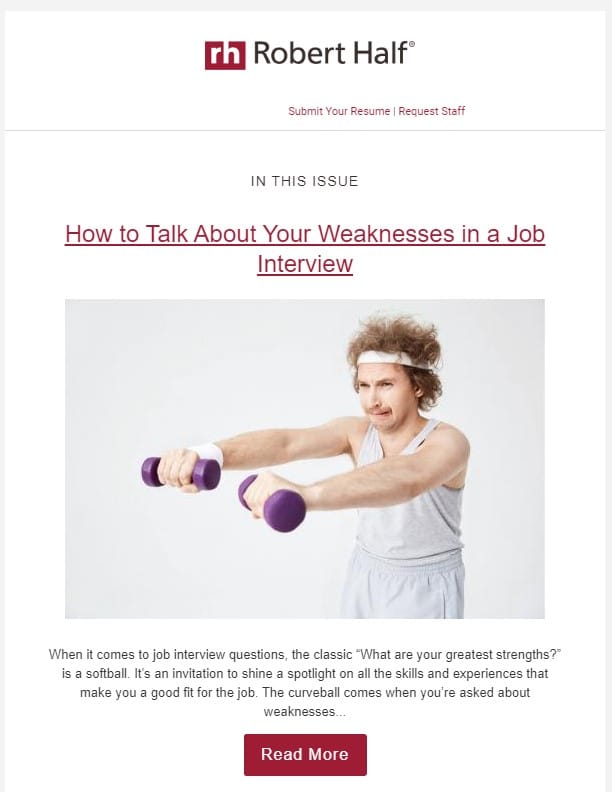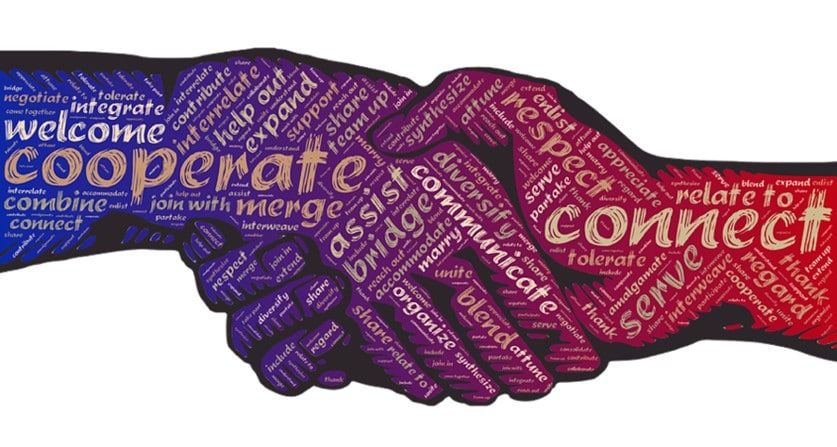
Making the Most of Your Company Newsletters
MAKING THE MOST OF YOUR COMPANY NEWSLETTERS
A newsletter can be a marketer’s best friend. But like any relationship, they require an investment of your time, an understanding of what makes them tick, and some tender, loving care.
There are a few key factors you need to consider and best practices to implement before making a newsletter a regular part of your communications strategy.
Printed vs. Electronic? What is your delivery method?
You need to decide the medium for your newsletter.
Will you produce something that needs to be printed and mailed, or will you create a newsletter on a digital platform like MailChimp or Constant Contact?
Below, we outline best practices for both.
Printed Newsletters
In this day in age, with so much electronic communication, the idea of receiving a printed newsletter might be a novel one.
Your target audience may appreciate the fact that you’re investing dollars to communicate with them, and they have something tangible to hold on to, clip, highlight, or pass on to someone else.
In a nutshell, they have a longer shelf life and are a great place to profile employees, clients, or donors. There is just something about seeing your name in print that is special.
If you decide a printed newsletter is a way to go for your organization or business, here are a few good rules of thumb, some of which apply to digital newsletters as well.
Create compelling content:
Regardless of your mode of delivery, your content needs to draw your readers in and keep them interested.
Guidestar, a popular resource for nonprofit organizations, says that your readers need to gain something from your communications so that they feel reading it was worth their time, and they look forward to the next edition.
Articles can be informational, inspirational, or educational as long you leave your readers with key takeaways.
Enlist professional design and writing services:
If you’re going to invest in doing a newsletter, consider hiring a professional graphic designer.
The designer has the skill set to design a template for you that is not only eye-catching but effective as well. And they can make the most out of “white” or “negative” space and choose fonts that strike an even balance between being inviting and being easy-on-the-eyes.
“A professional graphic designer can make sure your company’s branding and values are enhanced and reflected in a newsletter template while complementing the writer’s tone,” says Purvi Baron, principal of Sincera Designs, a Sugar Land, Texas-based graphic design firm.
You may also want to consider outsourcing to a professional writing firm.
These firms have a variety of talented individuals on their team who can efficiently create compelling and engaging copy. They offer a fresh, outside perspective, too, that you may not get working with someone in-house.
Use pull quotes:
A pull quote is a crucial phrase or excerpt from an article used as a graphical element in a layout, to help draw readers into the content.
See below for an example from Process Street of a pull quote and its use in a design.

Don’t ignore the back page:
There is a segment of the population that starts reading magazines, newsletters, and other printed materials from back to front.
Make sure your back page is just as engaging as the front.
Be consistent with your branding:
Your newsletter should reflect the look and feel of your organization or business. Make sure to include the logo and use your color palette.
These simple actions will help make your publications recognizable, and readers will begin to associate the newsletter that arrives in their mailbox with your organization or business.
Digital Newsletters
Electronic newsletters are much more cost-efficient than a printed newsletter and lend you the ability to send them out on a more regular basis.
And when you consider that, according to Pewresearch.com, 9 in 10 American adults use the Internet and three-quarters of the American population have Internet services at home, a digital newsletter might be your most effective mode of delivery.
Aside from some of the best practices that apply to printed newsletters, such as presenting engaging content, hiring a professional graphic designer and writing team, and being consistent with your branding, there are several “rules of thumb” when you decide to create and launch an email-based newsletter.
Personalization:
Several email-newsletter programs allow you to personalize content for the recipient.
Customizing your news may make your reader feel valued and important, and it will stand out from the rest of their inbox as well.
Mobile-friendly:
An article by CNBC says that three-quarters of the world will use their smartphones to access the Internet by the year 2025.
For this reason, you need to work with your designers and email developers to make sure your newsletter displays just as nicely on your mobile devices as it does on your PCs.
In fact, you may want to start the mobile design first. Failing to make your newsletters “responsive” will jeopardize your ability to engage with your readers.
Clever subject line:
We are inundated with mountains of emails every day. You need to be creative about your subject line so you can make your readers open the email newsletter you’ve worked so hard to create.
You might want to include words that ask a question or challenge the reader, or if appropriate, utilize humor.
A write-up in Inc.com provides some great examples of email subject lines. Here are just a few B2C examples the article cites:
- Travelocity: Need a day at the beach? Just scratch n’ sniff your way to paradise…
- Uber: Since we can’t all win the lottery…
- Overstock: Seriously. We’d like to thank you.
- Grubhub: Last Day To See What This Mystery Email Is All About
- Groupon: Deals That Make Us Proud (Unlike Our Nephew, Steve)
- Eater Boston: Where to Drink Beer Right Now (Sent at 6:45am on a Wednesday)
- Fabletics: Your Butt Will Look Great in These Workout Pants
- UrbanDaddy: You’ve Changed
- Influitive: So I’ll pick you up at 7?
- BloomThat: Better than a pumpkin spice latte!
- Gap: Mondays are suddenly AWESOME
- The Bold Italic: Just P100ho You: Where to Eat SF’s Best Pho
- The Muse: We Like Being Used
Vertical Response provides the following as examples for B2B subject lines:
- How to Leverage (your product) in Your Business
- Save Money and Look Like a Star to Your Boss
- How to Impress Your CFO — Save $1000
- Increase Your ROI by 30%, Guaranteed
- How to make it onto your buyer’s shortlist
- Free Webinar: [insert webinar name]
- Now you can do even more with your (xxxx) should your company outsource (insert thing to outsource here)?
- Breakfast & Secrets for How to (insert the problem you solve or the product you sell)
- Success Tip: 5 Ways to a Better (xxxx)
Crystal clear call-to-action (CTA):
When a subscriber opens your newsletter, not only should they find the content valuable, they should also know immediately what action to take, whether it’s to read a blog post linked to your website, register for an event, or make a donation.
Any CTA buttons should be prominent in your email design, with straightforward copy to help the reader take the desired action.
Here’s a great example from BikeHouston:
Actionable language with links:
It’s best to avoid phrases like “click here” for more. Instead, use other verbs like “read,” “donate,” “subscribe,” “learn,” or “share.”
Short and sweet: Do what you can to drive readers to your website. Consider doing a summary with teases that allow the reader to skim and then dive further into a particular article if it piques their interest. Here’s a good example of how Robert Half, a staffing and recruiting firm, does this:

Make it scannable:
Today we are all bombarded with electronic information. Consider including only three to five articles in your newsletter and organize them in a way that makes sense to the reader, with your most important message at the beginning.
Test and test again:
One of the best parts of electronic communication is the opportunity you have to test before launch.
Take advantage of this ability to ensure you have multiple eyes on the final product before it goes live to everyone.
How often will you send them?
Regardless of how your newsletter is delivered, you need to be consistent in its production and release date. You need to commit to a regular schedule to truly engage with your readers.
Newsletters, whether they are printed or emailed, are a labor of love and take significant time to produce.
You need to account for planning the editorial content, writing the articles, editing/revisions, gathering quality photos, corrections, and securing approval.
If the purpose of your newsletter is to keep employees informed, you may want to consider publishing something at least monthly.
If your newsletter is for external audiences, you may want to consider sending it out monthly or quarterly.
Whatever schedule you choose, make sure you are being consistent with your communications and not sporadic. Your audience will anticipate receiving your newsletter and come to expect them on a regular schedule.
What types of articles should your newsletter include?
When considering the content for your newsletter, you should think about including a message from leadership.
If you are producing a newsletter for employees, especially a Fortune 500 company with hundreds of employees, an article from leadership might serve as one of the only regular touchpoints your team has with the C-suite.
If you are producing a newsletter for an external audience for a nonprofit, for example, you definitely want to include a message from your executive director so that your audience, especially donors, are in tune with and hear from those at the top.
Your newsletter should also include a summary of what is happening at your organization and a list of current activities and events.
It should serve as another way to help grow your social media audience and include a call to action for people to follow your organization on Facebook, Twitter, Instagram, and other social media.
How should you measure success?
The production and distribution of newsletters take dedication and amazing attention to detail, not to mention time and energy.
You want to know that you’re being successful and hitting the mark with your readers.
Even if you choose to do a printed newsletter, you should consider sending a survey to gauge which articles subscribers are reading and what readers would like to see in future issues.
If you go the digital route, you need to take the following metrics into account:
- Open-rate: MailChimp.com defines “open-rate” as the percentage that tells you how many recipients opened the email. MailChimp analyzed open-rates and found the average across a variety of industries was 21.33%.
- Click-through rate: MailChimp describes the click-through rate as the percentage of subscribers that took action to click-through to your website. This number reflects whether your audience found your newsletter interesting enough to click through to learn more. The average click-through rate, according to MailChimp, is 2.62%.
- Bounce-rate: Finally, there’s bounce-rate. Bounces happen when an email can’t be delivered either because the email address is not valid or because a mailbox was too full or temporarily unavailable. A good bounce-rate, according to ConstantContact.com, is about 7.75% across all industries.
If you want to improve any of these metrics, you may want to revisit your email subject lines and make sure you have up-to-date email addresses for your subscribers.
How to Get More Subscribers
One of the main goals of a newsletter is to grow your community of supporters, advocates, donors, and consumers. Here are a few ideas:
- Have a way to capture subscribers at in-person events. You can have an ole’ fashion sign-up sheet, or better yet, an iPad or other digital device to obtain people’s information.
- Cross-promote your newsletter on Facebook and/or Twitter. Provide a link directly to the sign-up page on your website.
- Encourage social media sharing in your newsletter.
A Helpful Resource for Readers
A newsletter, whether it be internal or external, is a great way to get in front of your audiences and communicate information you need them to know.
“During the COVID-19 pandemic, strong communication within newsletters has been instrumental in staying connected with employees and patients. The goal is to not inundate them—but work towards consolidation and educational information,” says Melissa McDonald, assistant director of marketing and communications for UT Physicians.
“The idea is to pull all of the information into one communication that they can then circle back on if they have questions. We use an external platform to generate our newsletters, so we have trackable information on what people are reading. When you have tracking information, it allows you to hone in on what your consumers want—and your employees.”
Related Content
- 0 Comment
Subscribe to Newsletter
- Elevate Your Content: How To Use Canva for Eye-Catching Visuals
- These Tools Are Your Key to the Content Campaign Kingdom
- Strategic Content Marketing: Distribution Methods for Maximum Reach
- The Abilities and Limitations of AI in Content Creation
- How to Use AI to Power Up Your Marketing Communication Strategy





